Accepted Scientific Name: Agave utahensis Engelm. in S.Watson
Botany [Fortieth Parallel] 497. 1871; vol. 5 S.Watson

Agave haynaldii var. utahensis (Agave utahensis) Photo by: Forest Starr & Kim Starr
Habit at Calico Hills Sandstone Quarry Calico Tanks trail Red Rocks, Nevada. December 26, 2007.
Synonyms:
See all synonyms of Agave utahensis
Common Names include:
ENGLISH: Utah Agave, Grand Canyon century plant
ARABIC ( لعربية ): أجاف يوتاهنسس
SPANISH (Español): Agave de Utah
TURKISH (Türkçe): Utah sabırı
Description: Agave utahensisSN|581]]SN|581]] (Grand Canyon century plant) is generally considered one of the most cold-tolerant century plants because it grows farther north than the rest of the species in the genus, in North Arizona and southern Utah. The rosettes, which are about a foot (30 cm) tall and slightly wider, are made of many, narrow leaves with teeth along the margins.
Subspecies, varieties, forms and cultivars of plants belonging to the Agave utahensis group
Agave utahensis is variable over its range and comprises two subspecies, subsp. kaibabensis and subsp. utahensis, the latter of which comprising at least 2 varieties, var. nevadensis and var. eborispina. These varieties are now regarded by some botanists as mere ecotypes or geographical forms, so now they are all synonymized with Agave utahensis, but still considered distinct by collectors for their peculiar traits.
 Agave utahensis Engelm. in S.Watson: (subsp. utahensis)
Agave utahensis Engelm. in S.Watson: (subsp. utahensis)  Agave utahensis var. eborispina (Hester) Breitung: has the longest spines of any, often cream or white in colour. Forms small clumps with only a few stems. Distribution: Nopah Mountains
Agave utahensis var. eborispina (Hester) Breitung: has the longest spines of any, often cream or white in colour. Forms small clumps with only a few stems. Distribution: Nopah Mountains Agave utahensis subs. kaibabensis (McKelvey) Gentry: is an attractive solitary form with bright green leaves and grey-white teeth. Leaves 3–5.5 cm wide; rosettes 4–10 dm wide; flowers (2.6–)2.9–4.3 cm long. Know only from northern arizona.
Agave utahensis subs. kaibabensis (McKelvey) Gentry: is an attractive solitary form with bright green leaves and grey-white teeth. Leaves 3–5.5 cm wide; rosettes 4–10 dm wide; flowers (2.6–)2.9–4.3 cm long. Know only from northern arizona. Agave utahensis var. nevadensis Engelm. ex Greenm. & Roush: smaller than type, has broader, bluish green leaves with strong marginal teeth. It suckers slowly eventually forming a large matt of spines where you can't tell which leaf belongs to which plant.
Agave utahensis var. nevadensis Engelm. ex Greenm. & Roush: smaller than type, has broader, bluish green leaves with strong marginal teeth. It suckers slowly eventually forming a large matt of spines where you can't tell which leaf belongs to which plant.
Bibliography: Major references and further lectures
1) Joachim Thiede: “Agave utahensis.” In: Urs Eggli "Illustrated Handbook of Suculent Plants: Monocotyledons" Springer, 2001
2) Howard Scott Gentry “Agaves of Continental North America” University of Arizona Press, 01/Feb/2004
3) Gentry, H. S. 1972. “The agave family in Sonora.” U.S.D.A. Agric. Handb. 399. (Agave Sonora)
3) Wikipedia contributors. "Agave utahensis." Wikipedia, The Free Encyclopedia. Wikipedia, The Free Encyclopedia, 16 Jun. 2014. Web. 3 Nov. 2014.
4) August J. Breitung: "Agave utahensis" In: "The Agaves." The Cactus & Succulent Journal Yearbook, page 21.1968
5) Zlatko Janeba: “Komplex Agave utahensis.” In: Kaktusy Special 2. Page 5–14 2010
6) James L. Reveal, Wendy C. Hodgson: “Agave utahensis.” In: “Flora of North America.” page 450–451 2002
7) Urs Eggli (Hrsg.): "Sukkulenten-Lexikon. Einkeimblättrige Pflanzen (Monocotyledonen)." Eugen Ulmer, Stuttgart 2001, ISBN 3-8001-3662-7, S. 69.
8) James L. Reveal & Wendy C. Hodgson: “Flora of North America Agavaceae.” 2002
9) Urs Eggli, Leonard E. Newton: "Etymological Dictionary of Succulent Plant Names." Springer, Berlin/Heidelberg 2010
10) George Engelmann: “Yucca, Agave, Hesperaloe” In: Sereno Watson u.a: “Botany. United States Geological Exploration of the fortieth parallel”. Volume 5, United States Government Printing Office, Washington 1871
11) Abrams, L. 1923. “Ferns to Birthworts.” 1: 1–557. In L. Abrams (ed.) “Ill. Fl. Pacific States.” Stanford University Press, Stanford.
12) Bailey, L.H. & E.Z. Bailey. 1976. “Hortus Third” i–xiv, 1–1290. MacMillan, New York.
13) Flora of North America Editorial Committee, e. 2002. “Magnoliophyta: Liliidae: Liliales and Orchidales.” Fl. N. Amer. 26: i–xxvi, 1–723.
14) Hickman, J. C. 1993. “The Jepson Manual: Higher Plants of California” 1–1400. University of California Press, Berkeley.
15) Shreve, F. & I. L. Wiggins. 1964. “Veg. Fl. Sonoran Des.” 2 vols. Stanford University Press, Stanford.
16) Albano, P.-O. (2003). "La Conaissance des Plantes Exotiques" 1-324. Édisud, Aix-en-Provence.
17) Encke, F. et al. 1984. ”Zander: Handwörterbuch der Pflanzennamen,” 13. Auflage. (Zander ed13)
18) Albano, P.-O. (2003). “La Conaissance des Plantes Exotiques:” 1-324. Édisud, Aix-en-Provence.
19) Govaerts, R. (1995). “World Checklist of Seed Plants” 1(1, 2): 1-483, 1-529. MIM, Deurne.
20) Leo J. Chance "Cacti and Succulents for Cold Climates: 274 Outstanding Species for Challenging Conditions" Timber Press, 19/Jun/2012
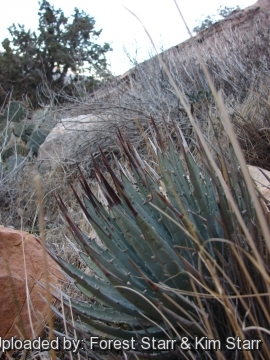 Habit at Childrens Discovery Loop Red Rocks, Nevada. December 26, 2007. (Agave utahensis) Photo by: Forest Starr & Kim Starr
Habit at Childrens Discovery Loop Red Rocks, Nevada. December 26, 2007. (Agave utahensis) Photo by: Forest Starr & Kim Starr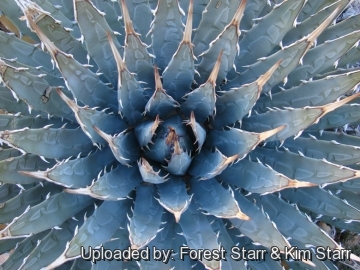 Rosette at Calico Hills Sandstone Quarry Calico Tanks trail Red Rocks, Nevada. December 26, 2007. (Agave utahensis) Photo by: Forest Starr & Kim Starr
Rosette at Calico Hills Sandstone Quarry Calico Tanks trail Red Rocks, Nevada. December 26, 2007. (Agave utahensis) Photo by: Forest Starr & Kim Starr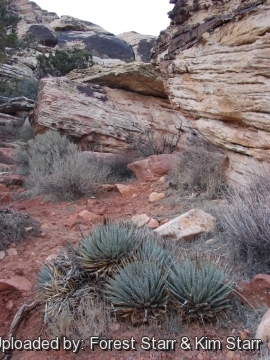 Habit at Childrens Discovery Loop Red Rocks, Nevada. December 26, 2007. (Agave utahensis) Photo by: Forest Starr & Kim Starr
Habit at Childrens Discovery Loop Red Rocks, Nevada. December 26, 2007. (Agave utahensis) Photo by: Forest Starr & Kim Starr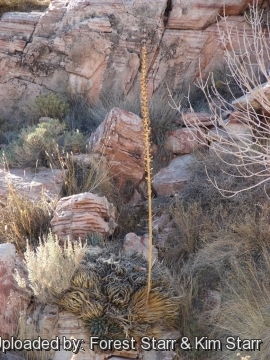 Flowering habit at Calico Basin, Nevada. December 22, 2007. (Agave utahensis) Photo by: Forest Starr & Kim Starr
Flowering habit at Calico Basin, Nevada. December 22, 2007. (Agave utahensis) Photo by: Forest Starr & Kim Starr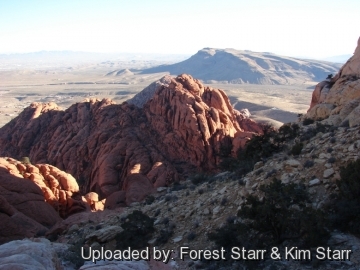 Habitat and view from top of trail at Calico Hills Sandstone Quarry Calico Tanks trail Red Rocks, Nevada. December 26, 2007. (Agave utahensis) Photo by: Forest Starr & Kim Starr
Habitat and view from top of trail at Calico Hills Sandstone Quarry Calico Tanks trail Red Rocks, Nevada. December 26, 2007. (Agave utahensis) Photo by: Forest Starr & Kim Starr Habit at Calico Hills Sandstone Quarry Calico Tanks trail Red Rocks, Nevada. December 26, 2007. (Agave utahensis) Photo by: Forest Starr & Kim Starr
Habit at Calico Hills Sandstone Quarry Calico Tanks trail Red Rocks, Nevada. December 26, 2007. (Agave utahensis) Photo by: Forest Starr & Kim StarrCultivation and Propagation: It is a very cold hardy form of the species. It is theoretically hardy to -18°C (or more) particularly when dry. It is a relative easy-to-grow species. Need a very well-drained, soil. It grows fairly fast in summer if provided with copious water but allows to dry thoroughly before watering again. During the winter months, one should only water enough to keep the leaves from shrivelling. They do well in full sun or a lightly shaded area. Plants cultivated outdoors are drought tolerant and takes blasting heat and full sun. It is a wonderful companion plant for Echinocereus and Escobaria cacti species. During the beautiful season it’s good to enrich the soil using a fertilizer rich in potassium and phosphorous, but poor in nitrogen, because this chemical element doesn’t help the development of succulent plants, making them too soft and full of water.
This stylish succulent has long been highlighted in gardening magazines and television shows. They are great used as feature plants in Mediterranean and modern style landscapes, pots and containers, rockeries, embankments and tropical style gardens.
Propagation: Suckers or seed.
SUCKERS: Remove the basal suckers (if available) in spring or summer and let the cuttings dry for a few days before inserting in compost.
SEEDS: Sow at any time of year in a well-aerated compost at a temperatures of 22-24°C . Stand the pots in water, moisten thoroughly and drain. Scatter and press lightly the seed onto the top of the compost. But do not cover the small seeds with compost. Secure a polythene bag around the pot or cover the container with glass or and place in a warm shaded place. If possible, germinate in a propagator.
Some seedlings may appear within a week or 10 days others will take longer. At lower temperatures, germination usually takes considerably longer. Once germination has taken place, remove gradually the glass or plastic and move into a good light but not in direct sun. If the young plants are exposed to too much sun, or the compost dries out, they may stop growing and often turn red; once they stop, it is often difficult to persuade them to start growing again. Never let the pots dry out-but don't saturate them either. A sodden compost is as harmful as a dry one.
Uses:*
1) The plant was used for food by local Native American peoples. Seed may be ground into flour. Flower stalk, roasted, & the Root cooked. The heart of the plant, which is partly below ground, is very rich in saccharine matter and can be eaten when baked. It is sweet and delicious and can be dried for future use or soaked in water to produce a flavourful beverage. Sap from the cut flowering stems is used as syrup. The sap can also be tapped by boring a hole into the middle of the plant at the base of the flowering stem. It can also be fermented into 'Mescal', a very potent alcoholic drink!
2) It has very good fibres which withstand hard wear and are water-resistant, that are used mainly in brush making, but they are occasionally used for textiles (can be spun, or made into rope)
















